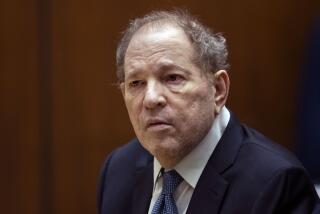Culture : Buddhism Rising Again From the Ashes of Cambodia : The Khmer Rouge used genocide to try to eradicate the religion. Its comeback is slow but steady.
The lilting voices of young men chanting prayers in Pali, the language of Buddhist scripture, drifted with hypnotic rhythm from a ramshackle schoolroom at the Temple Tuol Tompoung, another sign of Cambodia’s slow climb back from the abyss.
The Pali school was opened only four months ago, the first in Cambodia to teach the language since the Khmer Rouge went on a rampage in 1975 in a nearly successful effort to erase Buddhism from the national psyche.
Before the Khmer Rouge came to power, Buddhism was much more than a religion in Cambodia. The temple, or wat, was not only a religious place but in most areas of the country also served as the primary school and center of social and intellectual life. Pali schools flourished as early as the 13th Century.
By official count, there were more than 4,000 temples and 66,000 monks--1% of the population--before the Khmer Rouge came to power. A government statement in April, 1989, noted that the Khmer Rouge had executed more than 25,000 monks, including the chief monk, Huot Tat, and destroyed 1,968 temples and monasteries.
“The people began to have a cruel and barbarous character,” recalled Tep Vong, who is now Cambodia’s chief monk. “I think it depended on the leadership. The Khmer Rouge knew most people practiced Buddhism. They simply declared there was no Buddhism in Cambodia.”
Monks were defrocked and made to work in the fields. The Khmer Rouge made former monks eat large afternoon and evening meals, in violation of their dietary laws, and to drink alcohol. Temples were used to house pigs.
Now, the striking gabled roofs of the Buddhist temples, glinting with gold and a rainbow of colors, are visible everywhere in the countryside, towering over fields planted with rice.
But “it will take a long time to restore Buddhism to our country,” Tep Vong said.
Although heavily damaged, the Temple at Tuol Tompoung survived because the Khmer Rouge found it a convenient prison. Of the 80 monks who once lived here, only one survived.
“I was forced to leave the monkhood,” Han Kim, the survivor, said. “I worked in a workshop making plows. Monks were dying from hard labor, starvation and a lack of medicine. I was still praying, but I could let nobody know.”
When the Khmer Rouge were ousted by the Vietnamese in early 1979, the temples were reopened, but Buddhism seemed to have an ambivalent relationship with the government, which was officially Marxist. The government established 50 as the minimum age for monks; it was trying to increase the devastated population and wanted young men to marry. Now young boys may become monks, but they need the permission of their local mayor.
Tep Vong became a political figure friendly to the government by becoming a member of the National Assembly. He even traveled to the Soviet Union for education.
But in June, 1989, under a series of reforms, the government of Premier Hun Sen re-established Buddhism as the state religion. Indeed, most Cambodians had already returned to the fold, including Chea Sim, the No. 2 man in the government, who spent a number of years as a monk.
Some diplomats argued that the government wanted to put on its best face before negotiating with Western powers. It also made good sense politically to embrace Buddhism, since the religion is practiced by 85% of the population.
The primary school at Tol Tompoung now has 3,000 students in two shifts. The Pali school, which offers a course of study for novice monks that lasts 17 years, started in January and now has 80 students. A second school has reopened on the outskirts of Phnom Penh. The monks, who range in age from 7 to 21 years old, study five hours a day.
Because the Khmer Rouge burned all Buddhist texts, the students have no books. They are learning the intricate language from monks, using their memories and blackboards.
“I will spend my entire life as a monk, so I want to learn every detail,” said Cheak Si Chan, an 18-year-old novice who was one of the first chosen for the new school.
The novices, with their shaved heads and saffron robes, have become a daily sight in the big cities, riding motorcycles and collecting alms in their elaborate way--not begging or asking for money, but standing mute and glacially still in front of a shop or business until a donation is placed in the large sack they carry over their shoulders.
A puzzling question in Cambodia, reminiscent of the guilt in Germany after World War II, is how a country with such strong Buddhist traditions could be swept up in the sort of national killing spree that took place in the 1960s.
“It was the ideology of the time,” Vep Tong said. “(Khmer Rouge leader Pol Pot) gave orders to destroy the temples. The people obeyed their leaders. If they disobeyed, they would be taken away and killed.”
Buddhist Genocide
When the Khmer Rouge came to power in Cambodia in April, 1975, there were more than 4,000 Buddhist temples and 66,000 monks in the country. According to a government report released in April, 1989, more than 25,000 monks were killed, and 1,968 temples and monasteries were destroyed while the Khmer Rouge was in power.
Temples: Pre-Khmer Rouge: 4,000 Post-Khmer Rouge: 2,032
Monks: Pre-Khmer Rouge: 66,000 Post-Khmer Rouge: 41,000
More to Read
Start your day right
Sign up for Essential California for news, features and recommendations from the L.A. Times and beyond in your inbox six days a week.
You may occasionally receive promotional content from the Los Angeles Times.






